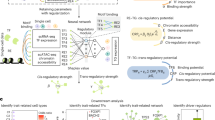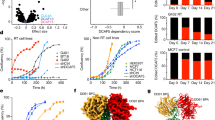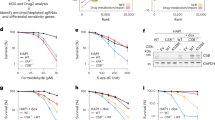Abstract
Developmental silencing of fetal globins serves as both a paradigm of spatiotemporal gene regulation and an opportunity for therapeutic intervention of β-hemoglobinopathy. The nucleosome remodeling and deacetylase (NuRD) chromatin complex participates in γ-globin repression. We used pooled CRISPR screening to disrupt NuRD protein coding sequences comprehensively in human adult erythroid precursors. Essential for fetal hemoglobin (HbF) control is a non-redundant subcomplex of NuRD protein family paralogs, whose composition we corroborated by affinity chromatography and proximity labeling mass spectrometry proteomics. Mapping top functional guide RNAs identified key protein interfaces where in-frame alleles resulted in loss-of-function due to destabilization or altered function of subunits. We ascertained mutations of CHD4 that dissociate its requirement for cell fitness from HbF repression in both primary human erythroid precursors and transgenic mice. Finally we demonstrated that sequestering CHD4 from NuRD phenocopied these mutations. These results indicate a generalizable approach to discover protein complex features amenable to rational biochemical targeting.
This is a preview of subscription content, access via your institution
Access options
Access Nature and 54 other Nature Portfolio journals
Get Nature+, our best-value online-access subscription
$29.99 / 30 days
cancel any time
Subscribe to this journal
Receive 12 print issues and online access
$209.00 per year
only $17.42 per issue
Buy this article
- Purchase on Springer Link
- Instant access to full article PDF
Prices may be subject to local taxes which are calculated during checkout






Similar content being viewed by others
Data availability
The data that support the findings of this study are available from the corresponding author upon request. Data and analysis are included in the article and Supplementary Note. Mass spectrometery raw data is accessable from proteomecentral under accession no. PXD009793. Next-generation sequencing (NGS) data (RNA-seq and CRISPR screen) are available from NCBI SRA portal under accession No. PRJNA496556.
Code availability
For analysis and visualization of functional readout from tiled pooled CRISPR screen, we used a custom computational pipeline available at https://gitlab.com/bauerlab/crispro.
References
Modell, B. & Darlison, M. Global epidemiology of haemoglobin disorders and derived service indicators. Bull. World Health Organ 86, 480–487 (2008).
Piel, F. B. et al. Global epidemiology of sickle haemoglobin in neonates: a contemporary geostatistical model-based map and population estimates. Lancet 381, 142–151 (2013).
Darling, R. C., Smith, C. A., Asmussen, E. & Cohen, F. M. Some properties of human fetal and maternal blood. J. Clin. Invest. 20, 739–747 (1941).
Schroeder, W. A., Shelton, J. R., Shelton, J. B. & Cormick, J. The amino acid sequence of the alpha chain of human fetal hemoglobin. Biochemistry 2, 1353–1357 (1963).
Blau, C. A. & Stamatoyannopoulos, G. Hemoglobin switching and its clinical implications. Curr. Opin. Hematol. 1, 136–142 (1994).
Vinjamur, D. S., Bauer, D. E. & Orkin, S. H. Recent progress in understanding and manipulating haemoglobin switching for the haemoglobinopathies. Br. J. Haematol. 180, 630–643 (2017).
Bauer, D. E., Brendel, C. & Fitzhugh, C. D. Curative approaches for sickle cell disease: a review of allogeneic and autologous strategies. Blood Cells Mol. Dis. 67, 155–168 (2017).
Nuinoon, M. et al. A genome-wide association identified the common genetic variants influence disease severity in beta0-thalassemia/hemoglobin E. Hum. Genet 127, 303–314 (2010).
Lettre, G. et al. DNA polymorphisms at the BCL11A, HBS1L-MYB, and beta-globin loci associate with fetal hemoglobin levels and pain crises in sickle cell disease. Proc. Natl Acad. Sci. USA 105, 11869–11874 (2008).
Torchy, M. P., Hamiche, A. & Klaholz, B. P. Structure and function insights into the NuRD chromatin remodeling complex. Cell Mol. Life Sci. 72, 2491–2507 (2015).
Millard, C. J. et al. The structure of the core NuRD repression complex provides insights into its interaction with chromatin. eLife 5, e13941 (2016).
Kransdorf, E. P. et al. MBD2 is a critical component of a methyl cytosine-binding protein complex isolated from primary erythroid cells. Blood 108, 2836–2845 (2006).
Harju-Baker, S., Costa, F. C., Fedosyuk, H., Neades, R. & Peterson, K. R. Silencing of a gamma-globin gene expression during adult definitive erythropoiesis mediated by GATA-1-FOG-1-Mi2 complex binding at the −566 GATA site. Mol. Cell Biol. 28, 3101–3113 (2008).
Rupon, J. W., Wang, S. Z., Gaensler, K., Lloyd, J. & Ginder, G. D. Methyl binding domain protein 2 mediates gamma-globin gene silencing in adult human betaYAC transgenic mice. Proc. Natl Acad. Sci. USA 103, 6617–6622 (2006).
Gnanapragasam, M. N. et al. p66Alpha-MBD2 coiled-coil interaction and recruitment of Mi-2 are critical for globin gene silencing by the MBD2-NuRD complex. Proc. Natl Acad. Sci. USA 108, 7487–7492 (2011).
Xu, J. et al. Corepressor-dependent silencing of fetal hemoglobin expression by BCL11A. Proc. Natl Acad. Sci. USA 110, 6518–6523 (2013).
Costa, F. C., Fedosyuk, H., Chazelle, A. M., Neades, R. Y. & Peterson, K. R. Mi2beta is required for gamma-globin gene silencing: temporal assembly of a GATA-1-FOG-1-Mi2 repressor complex in beta-YAC transgenic mice. PLoS Genet. 8, e1003155 (2012).
Amaya, M. et al. Mi2beta-mediated silencing of the fetal gamma-globin gene in adult erythroid cells. Blood 121, 3493–3501 (2013).
Bradner, J. E. et al. Chemical genetic strategy identifies histone deacetylase 1 (HDAC1) and HDAC2 as therapeutic targets in sickle cell disease. Proc. Natl Acad. Sci. USA 107, 12617–12622 (2010).
Esrick, E. B., McConkey, M., Lin, K., Frisbee, A. & Ebert, B. L. Inactivation of HDAC1 or HDAC2 induces gamma globin expression without altering cell cycle or proliferation. Am. J. Hematol. 90, 624–628 (2015).
Shearstone, J. R. et al. Chemical inhibition of histone deacetylases 1 and 2 induces fetal hemoglobin through activation of GATA2. PLoS ONE 11, e0153767 (2016).
Uda, M. et al. Genome-wide association study shows BCL11A associated with persistent fetal hemoglobin and amelioration of the phenotype of beta-thalassemia. Proc. Natl Acad. Sci. USA 105, 1620–1625 (2008).
Menzel, S. et al. A QTL influencing F cell production maps to a gene encoding a zinc-finger protein on chromosome 2p15. Nat. Genet. 39, 1197–1199 (2007).
Bauer, D. E. et al. An erythroid enhancer of BCL11A subject to genetic variation determines fetal hemoglobin level. Science 342, 253–257 (2013).
Liu, N. et al. Direct promoter repression by BCL11A controls the fetal to adult hemoglobin switch. Cell 173, 430–442 e17 (2018).
Sankaran, V. G. et al. Human fetal hemoglobin expression is regulated by the developmental stage-specific repressor BCL11A. Science 322, 1839–1842 (2008).
Thein, S. L. et al. Intergenic variants of HBS1L-MYB are responsible for a major quantitative trait locus on chromosome 6q23 influencing fetal hemoglobin levels in adults. Proc. Natl Acad. Sci. USA 104, 11346–11351 (2007).
Sankaran, V. G. et al. Developmental and species-divergent globin switching are driven by BCL11A. Nature 460, 1093–1097 (2009).
Sankaran, V. G. et al. A functional element necessary for fetal hemoglobin silencing. N. Engl. J. Med. 365, 807–814 (2011).
Xu, J. et al. Transcriptional silencing of {gamma}-globin by BCL11A involves long-range interactions and cooperation with SOX6. Genes Dev. 24, 783–798 (2010).
Yi, Z. et al. Sox6 directly silences epsilon globin expression in definitive erythropoiesis. PLoS Genet. 2, e14 (2006).
Xu, J. et al. Correction of sickle cell disease in adult mice by interference with fetal hemoglobin silencing. Science 334, 993–996 (2011).
Masuda, T. et al. Transcription factors LRF and BCL11A independently repress expression of fetal hemoglobin. Science 351, 285–289 (2016).
Schoonenberg, V. A. C. et al. CRISPRO: identification of functional protein coding sequences based on genome editing dense mutagenesis. Genome Biol. 19, 169 (2018).
Aguirre, A. J. et al. Genomic copy number dictates a gene-independent cell response to CRISPR/Cas9 targeting. Cancer Discov. 6, 914–929 (2016).
Munoz, D. M. et al. CRISPR screens provide a comprehensive assessment of cancer vulnerabilities but generate false-positive hits for highly amplified genomic regions. Cancer Discov. 6, 900–913 (2016).
Morgens, D. W., Deans, R. M., Li, A. & Bassik, M. C. Systematic comparison of CRISPR/Cas9 and RNAi screens for essential genes. Nat. Biotechnol. 34, 634–636 (2016).
Morgens, D. W. et al. Genome-scale measurement of off-target activity using Cas9 toxicity in high-throughput screens. Nat. Commun. 8, 15178 (2017).
Laurent, J. M. et al. Protein abundances are more conserved than mRNA abundances across diverse taxa. Proteomics 10, 4209–4212 (2010).
Vogel, C. & Marcotte, E. M. Insights into the regulation of protein abundance from proteomic and transcriptomic analyses. Nat. Rev. Genet 13, 227–232 (2012).
Gautier, E. F. et al. Comprehensive proteomic analysis of human erythropoiesis. Cell Rep. 16, 1470–1484 (2016).
Shi, J. et al. Discovery of cancer drug targets by CRISPR-Cas9 screening of protein domains. Nat. Biotechnol. 33, 661–667 (2015).
Torrado, M. et al. Refinement of the subunit interaction network within the nucleosome remodelling and deacetylase (NuRD) complex. FEBS J. 284, 4216–4232 (2017).
Scarsdale, J. N., Webb, H. D., Ginder, G. D. & Williams, D. C. Jr. Solution structure and dynamic analysis of chicken MBD2 methyl binding domain bound to a target-methylated DNA sequence. Nucleic Acids Res. 39, 6741–6752 (2011).
Liu, K. et al. Structural basis for the ability of MBD domains to bind methyl-CG and TG sites in DNA. J. Biol. Chem. 293, 7344–7354 (2018).
Lauffer, B. E. et al. Histone deacetylase (HDAC) inhibitor kinetic rate constants correlate with cellular histone acetylation but not transcription and cell viability. J. Biol. Chem. 288, 26926–26943 (2013).
Kumar, R. & Wang, R. A. Structure, expression and functions of MTA genes. Gene 582, 112–121 (2016).
Yang, N. & Xu, R. M. Structure and function of the BAH domain in chromatin biology. Crit. Rev. Biochem. Mol. Biol. 48, 211–221 (2013).
Ding, Z., Gillespie, L. L. & Paterno, G. D. Human MI-ER1 alpha and beta function as transcriptional repressors by recruitment of histone deacetylase 1 to their conserved ELM2 domain. Mol. Cell Biol. 23, 250–258 (2003).
Wang, X. et al. SMARCB1-mediated SWI/SNF complex function is essential for enhancer regulation. Nat. Genet. 49, 289–295 (2017).
Low, J. K. et al. CHD4 is a peripheral component of the nucleosome remodeling and deacetylase complex. J. Biol. Chem. 291, 15853–15866 (2016).
Demaison, C. et al. High-level transduction and gene expression in hematopoietic repopulating cells using a human immunodeficiency [correction of imunodeficiency] virus type 1-based lentiviral vector containing an internal spleen focus forming virus promoter. Hum. Gene Ther. 13, 803–813 (2002).
Esrick, E. B. & Bauer, D. E. Genetic therapies for sickle cell disease. Semin. Hematol. 55, 76–86 (2018).
Kurita, R. et al. Establishment of immortalized human erythroid progenitor cell lines able to produce enucleated red blood cells. PLoS One 8, e59890 (2013).
Canver, M. C. et al. BCL11A enhancer dissection by Cas9-mediated in situ saturating mutagenesis. Nature 527, 192–197 (2015).
Wu, Y. et al. Highly efficient therapeutic gene editing of human hematopoietic stem cells. Nat. Med. 25, 776–783 (2019).
Shalem, O. et al. Genome-scale CRISPR-Cas9 knockout screening in human cells. Science 343, 84–87 (2014).
Sanjana, N. E., Shalem, O. & Zhang, F. Improved vectors and genome-wide libraries for CRISPR screening. Nat. Methods 11, 783–784 (2014).
Chen, S. et al. Genome-wide CRISPR screen in a mouse model of tumor growth and metastasis. Cell 160, 1246–1260 (2015).
Doench, J. G. et al. Rational design of highly active sgRNAs for CRISPR-Cas9-mediated gene inactivation. Nat. Biotechnol. 32, 1262–1267 (2014).
Love, M. I., Huber, W. & Anders, S. Moderated estimation of fold change and dispersion for RNA-seq data with DESeq2. Genome Biol. 15, 550 (2014).
Cock, P. J. et al. Biopython: freely available Python tools for computational molecular biology and bioinformatics. Bioinformatics 25, 1422–1423 (2009).
Cifani, P. & Kentsis, A. High sensitivity quantitative proteomics using automated multidimensional nano-flow chromatography and accumulated ion monitoring on quadrupole-orbitrap-linear ion trap mass spectrometer. Mol. Cell Proteom. 16, 2006–2016 (2017).
Cox, J. et al. Accurate proteome-wide label-free quantification by delayed normalization and maximal peptide ratio extraction, termed MaxLFQ. Mol. Cell Proteom. 13, 2513–2526 (2014).
Kim, D. I. et al. An improved smaller biotin ligase for BioID proximity labeling. Mol. Biol. Cell 27, 1188–1196 (2016).
Seruggia, D., Fernandez, A., Cantero, M., Pelczar, P. & Montoliu, L. Functional validation of mouse tyrosinase non-coding regulatory DNA elements by CRISPR-Cas9-mediated mutagenesis. Nucleic Acids Res. 43, 4855–4867 (2015).
Harms, D. W. et al. Mouse genome editing using the CRISPR/Cas system. Curr. Protoc. Hum. Genet. 83, 1–27 (2014).
Pinello, L. et al. Analyzing CRISPR genome-editing experiments with CRISPResso. Nat. Biotechnol. 34, 695–697 (2016).
Acknowledgements
We thank X. Wang, C. Brendel, E. C. Smith, A. Gutierrez, G. D. Ginder and D. C. Williams for useful discussions and J. Desimini for graphical assistance. V.A.C.S. was supported by an Individual Travel Grant (ITG) from Radboud University. D.S.V. was supported by the Cooley’s Anemia Foundation. L.M.K.D. was supported by NHLBI (no. 5T32HL007574-36) and a Burroughs Wellcome Fund Postdoctoral Enrichment Grant (PDEP 1015098). S.A.W. and K.L. were supported by NIAID (no. R01AI117839) and NIGMS (no. R01GM115911). L.P. was supported by a National Human Genome Research Institute (NHGRI) Career Development Award (no. R00HG008399). T.M. was supported by NIH (no. 5R01DK111455) and JSPS Grant-in-Aid for Scientific Research A (no. 17H01567). A.K. is the Damon Runyon-Richard Lumsden Foundation Clinical Investigator and acknowledges support of the St. Baldrick’s Arceci Innovation Award, and NCI grant nos. R01 CA204396 and P30 CA008748. Generation of the mouse model was supported by a NIDDK Cooperative Centers of Excellence in Hematology (CCEH) award (no. U54DK110805) to S.H.O. S.H.O. was supported by the Doris Duke Charitable Foundation and is an Investigator of the Howard Hughes Medical Institute. D.E.B. was supported by NIDDK (grant nos. K08DK093705 and R03DK109232), NHLBI (nos. DP2OD022716 and P01HL032262), the Doris Duke Charitable Foundation, Burroughs Wellcome Fund, the American Society of Hematology and an Epigenetics Seed Grant from Harvard Medical School.
Author information
Authors and Affiliations
Contributions
F.S., T.M. and D.E.B. conceptualized the study. F.S., M.H., D.S., L.P., T.M., A.K., S.H.S. and D.E.B. provided methodology. V.A.C.S., M.A.C., Q.Y., C.M.T., P.G.S., M.C.C., L.P. and D.E.B. provided software. F.S., M.H., D.S., D.S.V., C.R., P.C., L.M.K.D., K.L., C.M.G. and Y.F. validated the project. F.S., V.A.C.S., Q.Y., M.A.C., L.P., T.M., A.K., S.H.O. and D.E.B. performed formal analysis. F.S., M.H., D.S., D.S.V., L.M.K.D., C.R., C.M.G. and Y.F. were investigators. C.R., K.L., R.K., Y.N., S.A.W., L.P., T.M., A.K., S.H.O. and D.E.B. provided resources. F.S., M.H., D.S., Q.Y. and D.E.B. curated data. F.S. and D.E.B. wrote the original draft. All authors reviewed and edited the article. F.S., M.H., D.S., V.A.C.S., M.A.C., Q.Y. and D.E.B. provided visualization. L.P., T.M., A.K., S.H.O. and D.E.B. supervised the research. D.E.B. was the project administrator. T.M., A.K., S.H.O. and D.E.B acquired funding.
Corresponding author
Ethics declarations
Competing interests
The authors declare no competing interests.
Additional information
Publisher’s note: Springer Nature remains neutral with regard to jurisdictional claims in published maps and institutional affiliations.
Supplementary information
Supplementary Information
Supplementary Note and Supplementary Figs. 1–9
Supplementary Table 1
Quantitative analysis of mass spectrometery data.
Supplementary Table 2
Functional scores of CRISPR library (all sgRNAs) against various protein-level sequence annotations.
Supplementary Table 3
List of oligonucleotides and PCR primer sequences used in the study.
Supplementary Table 4
Key resources.
Rights and permissions
About this article
Cite this article
Sher, F., Hossain, M., Seruggia, D. et al. Rational targeting of a NuRD subcomplex guided by comprehensive in situ mutagenesis. Nat Genet 51, 1149–1159 (2019). https://doi.org/10.1038/s41588-019-0453-4
Received:
Accepted:
Published:
Issue Date:
DOI: https://doi.org/10.1038/s41588-019-0453-4
This article is cited by
-
Chromatin complex dependencies reveal targeting opportunities in leukemia
Nature Communications (2023)
-
Collateral lethality between HDAC1 and HDAC2 exploits cancer-specific NuRD complex vulnerabilities
Nature Structural & Molecular Biology (2023)
-
Base editor scanning charts the DNMT3A activity landscape
Nature Chemical Biology (2023)
-
High-content CRISPR screening
Nature Reviews Methods Primers (2022)
-
Dual function NFI factors control fetal hemoglobin silencing in adult erythroid cells
Nature Genetics (2022)



